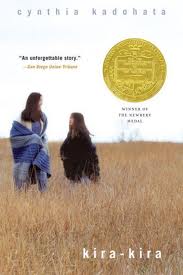kira-kira by Cynthia Kadohata
Reviewed by Ellen

2005 Newbery Medal Winner
Ratings Explanation
Language: “Shee-it”, s.o.b., hell, and one harsh profanity.
Violence: Katie hits Amber, her sister’s friend, in the face. Sam, the little brother, gets his foot caught in an animal trap. Katie’s father takes a 2×4 and smashes in the windshield of his boss’s Cadillac.
Sexual Content: Katie’s aunt and uncle go into a tent while camping and zip it shut; their son says, “They’re trying to make a baby. They do it all the time.” Katie ponders that she doesn’t know exactly what “making a baby” entails, but that it requires closed doors and hard work involving lots of grunting. Katie’s sister, Lynnie, describes French kissing to her. Lynnie kisses her boyfriend, Gregg. Katie has a dream where she and a boy get locked in a bathroom at a party and can’t get out, and wind up having to sleep next to each other in the bathtub (nothing happens.) While playing Scrabble, Katie’s cousin spells the word “sperm.”
Adult Themes: Uncle Katsuhisa chews tobacco. Katie steals baby chicks from a poultry farm to set them free. Katie steals nail polish from a drugstore to paint her sister’s fingernails while she lays sick. Lynnie becomes terminally ill with lymphoma and eventually dies.
Synopsis
Set in the 1950s, kira-kira is the story of two devoted Japanese sisters, Katie and Lynnie Takeshima, and the hardships, prejudice, and trials they suffer when their family moves to Georgia to find work for their parents. There are only a handful of Japanese people living and working in their small town, and since WWII has ended only a decade earlier, many people in town refuse to talk to or befriend them. Their parents are treated harshly and must work night and day to make ends meet. Their small Japanese community is tight-knit. On the night before Katie begins school, her mother cuts her long, straight hair and pin-curls it so she will look more American at school and be able to make friends. The little girls ask, “What did you do to your hair?” and “Are you Japanese or Chinese?” Katie and Lynnie are each other’s best friends and Lynnie, being the oldest, looks after Katie most of the time, tells her secrets, and explains life to her. Lynnie uses the Japanese word, kira-kira (kee-ra kee-ra) or “glittering” to describe things of beauty and impermanence: the stars twinkling, the sun reflecting on the ocean (even though she’s never seen it), people’s eyes when you look at them long enough. This becomes the theme of the book, as Katie will learn that Lynnie’s beautiful and too-short life is kira-kira when she becomes terminally ill with cancer.
This is a beautifully written and tearful book. Told from the point of view of young Katie (between ages six and eleven throughout the story), the author is adept at writing with the fresh and honest voice of a child, remembering and elaborating details that only a child might see. The story is sweet, funny, and poignant. Her vivid descriptions of growing up a Japanese-American struck a chord within me; she is proud to be Japanese, but yearns to feel accepted as an American at the same time. Katie’s painful descriptions of losing her sister are evocative and real. On the evening of the day her sister dies, Katie chases the sun down:
Through a break between the buildings, I saw that the sun hung low over the horizon. I watched it until it started to hide between two trees in the distance. Then I climbed on a car and watched until only half of the sun was visible, and then a quarter, and then I felt a huge sickening panic inside of me and ran as hard as I could to a ladder I saw down the alley. I rushed up the ladder and climbed on the roof of somebody’s garage. I saw the sun again, a quarter of it, and then a slice, and then it disappeared, the last time ever that the sun would set on a day my sister had lived.
Well worth one’s time to pick up this Newbery-winning book.









